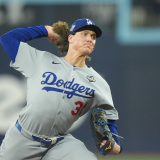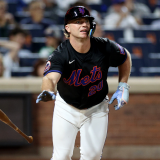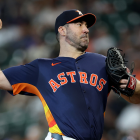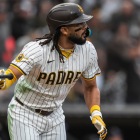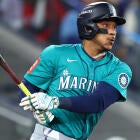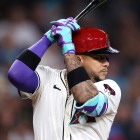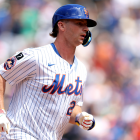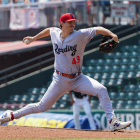MLB trends: Justin Verlander's playoffs question mark, Miguel Amaya's tweak and where James Wood can grow
There are less than three weeks to go in the 2024 regular season

Less than three weeks remain in the 2024 MLB regular season, and the various postseason races (and awards races) are really heating up. Everything will be decided by the end of the month. The marathon that is the regular season has become a sprint to the finish. With that in mind, here are three MLB trends worth knowing as we enter the stretch run.
Verlander losing grip on postseason rotation spot
The Astros are inevitable. They bottomed out at 12 games under .500 on May 8 and were 10 games behind the Mariners in the AL West on June 18, but a three-month rampage has pushed them into first place and in excellent position to win their fourth straight division title. The rotation was among the worst in baseball earlier this year. Now it's performing as one of the best.
The one exception: Justin Verlander. The future Hall of Famer got tagged for eight runs in three innings by the Diamondbacks this past Sunday, including giving up his first grand slam in 14 years. Before Pavin Smith on Sunday, the last player to hit a grand slam off Verlander was Luis Valbuena on April 11, 2010. Verlander faced 148 batters with the bases loaded between grand slams.
Sunday's disaster gives Verlander a 5.30 ERA and a .270/.331/.454 opponent's line through 14 starts, and he's allowed 19 runs in 17 2/3 innings in four starts since returning from a neck issue last month. Seven times in 14 starts he's allowed at least four runs. Only six times did he go a modest five innings with no more than two runs allowed. Has Father Time caught up to Verlander?
The D-backs swung and missed just twice at Verlander's 75 pitches Sunday, and he's gotten only 29 swings and misses in his four starts since coming off the injured list. There was a time Verlander could get 29 swings and misses in a single start (he last did it in 2019). Now the 41-year-old is struggling to miss bats, limit hard contact, and just pitch effectively.
The Astros are rolling with a six-man rotation at the moment and, objectively, Verlander is their least effective starter. Hunter Brown, Yusei Kikuchi, and Framber Valdez figure to be Houston's top three starters in the postseason in whatever order. Ronel Blanco and Spencer Arrighetti have both outpitched Verlander, though both are in uncharted territory with their innings total.
Entering play Tuesday, the Astros were 4 1/2 games behind the Guardians for the AL's No. 2 seed and a Wild Card Series bye. Houston may have to play in the Wild Card Series, which is a best of three. Brown, Kikuchi, and Valdez should start those three games (again, in whatever order). And if Verlander doesn't start, does he even make the postseason roster?
Only once in his MLB career -- a career that spans 19 seasons and 561 games pitched -- has Verlander come out of the bullpen. In Game 4 of the 2017 ALDS, he allowed a run in 2 2/3 innings of relief at Fenway Park. Can Verlander adjust his routine to pitch effectively in relief? Would the Astros put him in the bullpen? Would they leave him off the postseason roster entirely?
Those questions don't have to be answered right now. Verlander's track record means he'll have a long leash to try to work things out. Signs point to an aging player, however. Injuries are piling up, swings and misses are hard to come by, hitters are squaring him up for more often. Verlander has less than three weeks to show he belongs in Houston's postseason plans.
"I would not bet against someone with that pedigree and how good this guy's been for a very long time," Astros manager Joe Espada said after Sunday's game (via MLB.com). "I just know that he's going to go back and work and try to figure some stuff out. This guy has been really good for a very long time ... We have to go back to the drawing board and get him going. We need him."
Wood excelling without pulling the ball
While Jackson Holliday works to find his way at the big-league level, another one of the game's very best prospects has hit the ground running since being called up on July 1. Outfielder James Wood, who joined the Nationals in the Juan Soto trade with the Padres, took a .274/.367/.413 slash line in 60 games into play Tuesday. The 21-year-old has a strong 124 OPS+.
Wood is a large man -- he's officially listed at 6-foot-7 and 234 lbs. -- and his calling card is big-time power. He's an exit velocity and hard-hit rate king with ball-tracking data just south of Aaron Judge, so why then does he have only five home runs in 60 games? Well, part of that is being a rookie learning the ropes. But also, Wood does not pull the ball very often.
Here are Wood's fly balls and line drives since being called up:

Wood is a left-handed hitter and, generously, he's pulled six -- six! -- balls in the air to right field. His pulled fly ball rate is in the fourth percentile, so near the bottom of the league. Wood is strong enough to hit the ball out of the park the other way, but he'd get the most out of his power by pulling it to right. When you pull the ball, good things happen. Here are the MLB averages:
| AVG | SLG | |
|---|---|---|
Pull | .347 | .656 |
Center | .314 | .457 |
Oppo | .305 | .442 |
Singles to the opposite field are a Nice Piece Of Hitting but pulling the ball gets you to heaven. That's how you do the most damage and score the most runs. Wood, for all his power, has a higher opposite field rate (31.8%) than pull rate (29.1%). He's a power hitter with a slap hitter's spray chart. That he's been so productive is a testament to his raw power and hitting ability.
Wood is still finding his way in the league and, obviously, he's been very successful even while shooting the ball to left field. The next step is learning how to turn on a pitch and pull it to right field. That will turn his mammoth raw power into game power and more home runs. Give him time and he'll figure it out. For now, that's the clear next step in Wood's development.
Amaya's new leg kick paying dividends
This has no doubt been a disappointing season for Cubs, who, rather than take a step forward following last year's 83-79 finish, are on pace to finish with roughly the same record and again miss the postseason. The Cubs have not played playoff baseball since 2020. They haven't qualified for the postseason in a 162-game season since 2018. Ouch.
That said, there are brought spots for the Cubbies. Michael Busch and Pete Crow-Armstrong are cementing themselves at first base and center field, respectively. Shota Imanaga has exceeded expectations. Javier Assad is showing he's for real. And young Miguel Amaya is establishing himself behind the plate. We can split the 25-year-old's season into two unequal segments:
| First 63 games | Last 39 games | |
|---|---|---|
PA | 190 | 130 |
AVG/OBP/SLG | .186/.249/.256 | .294/.339/.487 |
2B | 4 | 8 |
HR | 2 | 5 |
K% | 22.1% | 12.3% |
BB% | 6.3% | 5.4% |
Barrel rate (what's this?) | 3.0% | 7.5% |
The endpoints are not arbitrary. From July 4-6, Amaya sat out three straight games to work on his hitting mechanics and correct what the Cubs felt was a timing issue. Specifically, the Cubs got him to ditch his leg kick for more of a toe turn. In 63 games before that behind-the-scenes work, Amaya was dreadful. In the 39 games since, he's been really good.
"A couple of years ago, that was my two-strike-approach stance, so it wasn't new for me at all," Amaya said soon after making the changes to his setup at the plate (via the Chicago Sun-Times). "... So far it's feeling good. It's something that I've just got to transfer to the game and go out there and compete with that."
Here is Amaya before and after his midseason mechanical changes:

Leg kicks and toe taps and toe turns are all about timing. With his leg kick, Amaya was rarely driving the baseball and too often popping up or hitting weak tappers. The toe turn has simplified everything and now there's more power behind his swing and he's more on time in general. The results were immediate too: 8 for 16 with a double and a homer in his first six games with the toe turn.
Amaya will play this entire season at age 25 and he was a staple on top-100 prospect lists from 2019-21, before Tommy John surgery derailed his development. He missed 2020 because of the pandemic and most of 2022 with elbow reconstruction. The learning curve at catcher is steep, and Amaya missed a lot of time at a crucial developmental age. It's been a grind for him.
This year, Amaya has finally been able to get regular playing time behind the plate -- being out of options has helped, the Cubs can't send him to Triple-A without exposing him to waivers -- and those early season struggles served a purpose. They showed him what he needed to fix, he went to work for three days in July, and now Amaya looks like a long-term answer behind the plate for Chicago.












